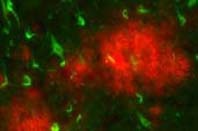
English French German Italian Hungarian
Alzheimer's disease - Clinical and pathological manifestations
Alzheimer's disease (AD) is the most frequent cause of dementia. It is characterized by a slowly progressive decline of memory and cognition. It starts with subtle short-term memory and anxio-depressive symptoms, orientation and language difficulties. Following a continuous slow progression, the intellectual functions virtually disappear and the patients loose their independence. They can survive in this devastating state, sometimes for more than a decade. Duration of the disease from the first symptoms until the manifestation of dementia varies between 5 and 20 years.

Senile plaques in Alzheimer’s disease are seen in red - and neurofibrillary tangles in green fluorescence. Anti-beta amyloid and anti-tau immunofluorescence staining, respectively.
The pathological hallmarks of Alzheimer’s disease consist of progressive brain atrophy, accumulation of cortical senile plaques, neurofibrillary tangles and the occurrence of neuronal loss and reactive astro- and microgliosis. Alzheimer’s disease is a form of amyloidosis where the aggregated amyloid substance is the amyloid beta peptide (Aβ).

